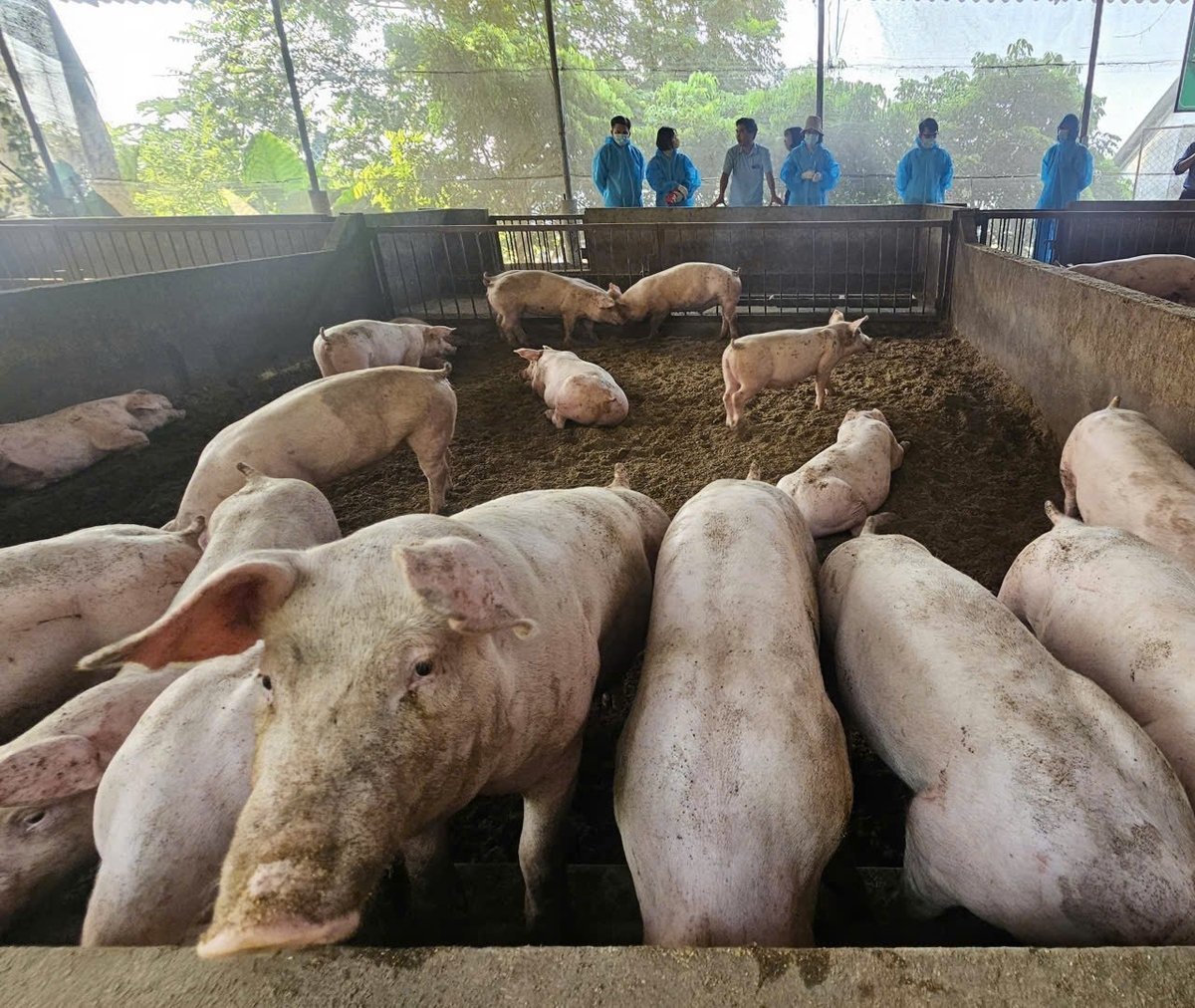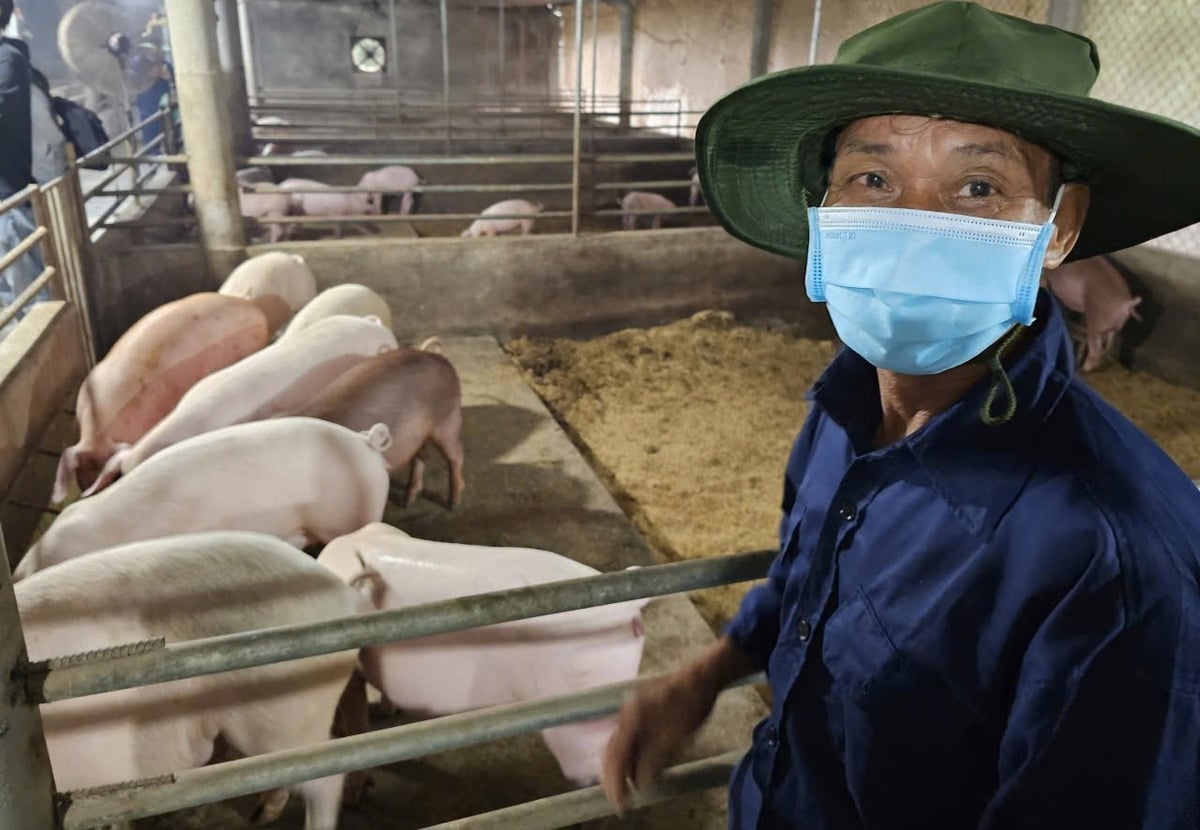December 30, 2025 | 22:38 GMT +7
December 30, 2025 | 22:38 GMT +7
Hotline: 0913.378.918
December 30, 2025 | 22:38 GMT +7
Hotline: 0913.378.918
A project to build an organic pork farming model with biosecurity and circular economy principles is being carried out by Que Lam Group in collaboration with the National Promotion Center for Agriculture and local authorities in the region of the former Vinh Phuc province (now the newly formed Phu Tho province), with more than 500 fattening pigs.

The biosecure farming model of Que Lam Group in Phu Tho. Photo: Bao Khang.
The project’s specific objective is to develop a pork farming model that meets ≥70% organic and closed-loop biosecurity criteria. The main approach is to treat agricultural waste with biological fermentation products to produce organic fertilizer, then use that fertilizer to grow crops such as corn, rice, and soybeans that supply pig feed; establish a linked farming and product-commercialization chain; and achieve economic gains of at least 10% above conventional pig farming.
In 2025, the project will be implemented in Dai Dinh, Xuan Lang, Vinh Thanh, and Tam Hong communes. Participating models have adopted the organic, biosecure farming techniques advocated by Que Lam Group.
Regarding pig feed, Que Lam produces feed from ingredients grown in organic farming chains and supplemented with probiotic blends. The feed in the model adheres to the five-no standards: no antibiotics, no chemicals, no growth promoters, no colorants, and no preservatives during production, packaging, or storage.
On the biofermentation product side, the project uses Japan-origin microbial technology to support probiotic cultures in feed and to create biological bedding that strengthens pigs’ resistance and keeps the farming environment odor-free. This reduces the need for bathing water and generates a bioferment byproduct, microbial organic fertilizer, for immediate use in farming, thereby supporting a circular, microbiological-based agriculture system.

Pig farming under the '5-no' standard. Photo: Bao Thang.
Le Manh Linh, Deputy Director of the National Promotion Center for Agriculture, said the Que Lam biosecure pig-farming project is a bright spot amid the African swine fever outbreak in Phu Tho.
Currently, Phu Tho has reported disease outbreaks in 119 of 148 communes/wards, with 118 outbreaks not yet observed for 21 days. The total number of households with pigs culled due to illness is nearly 7,500; pigs ill or dead and culled exceed 73,500; and total culled weight surpasses 4,340 tons.
Nevertheless, seven biosecure farming models in operation across the province are healthy and unaffected by African swine fever. By consistently applying biosecure farming processes on a bed of biological litter, using pre-mixed probiotic formulations in each type of feed and drinking water, and sanitizing the environment with probiotic products, the herds in these models remain healthy and immune to the disease.
Lang Van Hiep, owner of a biosecure farming model in Dai Dinh, said: “Our family raises about 600 pigs per year, earning a profit of 1.5–2 million VND per pig. By using probiotic products in farming, the manure is processed to fertilize a 600-tree grape garden, an 80-tree pomelo grove, and a 70-tree sapodilla orchard. Importantly, this biosecure process has kept our pig herd unaffected by African swine fever.”
Le Van Long, a farmer in Xuan Lang who farms 95 pigs, noted that the model safeguards against disease while delivering economic and environmental benefits suitable for smallholder and family farms. Market pork quality is consistently regarded as superior and commands higher prices.
“Rather than the previous approach of treating waste with a Biogas system, which wasted fertilizer resources for crops, this new process ensures circulation and leaves nothing behind. This is an excellent farming model that fits today’s farming realities, especially amid ASF and market volatility,” Long said.

Circular agricultural process. Photo: Bao Khang.
In an interview with Vietnam Agriculture and Nature News, Khac Ngoc Ba, Deputy General Director of Que Lam Group, stated: “Que Lam’s biosecure pig farming process is the result of research by the group’s scientists and has been recognized by the Ministry of Agriculture and Rural Development as a technical advancement in pig farming, including the improvement process using the Alfa Lacto 403 probiotic in biosecure pig farming".
Through the biosecure farming process, Que Lam has linked multiple models nationwide. To date, all cultivation models are safe from the epidemic.
From the farming models, a circular economy ecosystem has been built across 23 cooperatives with 1,338 households; 8 groups with 129 households; 6 enterprises and 100 individual growers connected directly, bringing the total number of organic, circular agricultural households in Que Lam’s network nationwide to 1,570.
“The economic benefits are substantial beyond disease safety and environmental improvements. Several Que Lam models have helped farmers earn 200–300 million VND per year”, Ba said.
Sustainable farming solutions
According to the National Promotion Center for Agriculture, recurring outbreaks of severe diseases such as African swine fever, foot-and-mouth disease, and blue-ear disease have caused heavy economic losses and disrupted the livelihoods of millions of livestock keepers. In most cases, the spread of disease results from noncompliance with biosecurity principles. Therefore, boosting biosecure farming is the key solution for sustainable livestock development.
Implementing biosecurity not only helps prevent, detect early, and control outbreaks, but also reduces treatment costs, minimizes animal losses, increases production efficiency and product value, meets traceability and food safety standards, protects the environment, and facilitates exports, helping to build a green, sustainable, circular agricultural economy.
Translated by Linh Linh

(VAN) Located in three former provinces, Nam Dinh, Thai Binh, and Ninh Binh, and now in two provinces, Ninh Binh and Hung Yen, "Red River Delta" is the name of Vietnam's first interprovincial coastal wetland World Biosphere Reserve.
/2025/12/29/1046-1-210728_624.jpg)
(VAN) In 2025, Viet Nam recorded severe and extreme disasters, breaking multiple historical records and causing heavy losses in lives, property, and infrastructure nationwide.

(VAN) Applied technologies, water-saving irrigation is a strategic solution to promote climate-resilient agriculture and strengthen water security in the uplands.
/2025/12/29/3936-3-163422_251.jpg)
(VAN) Can Gio mangrove forest in particular and the entire Can Gio Mangrove Biosphere Reserve in general hold great potential for carbon credits.

(VAN) Chu Pah Rubber has announced its products that comply with the EU Deforestation Regulation (EUDR), affirming its commitment to sustainable production and product origin transparency.

(VAN) Deputy Director Nguyen Hoai Nam stated that a digital data platform will be developed with agricultural sector databases, utilizing AI to help farmers make informed decisions on 'watering correctly, sufficiently, and efficiently.’
/2025/12/29/4841-2-134224_777.jpg)
(VAN) From only about 10 individuals in 2009, the wild elephant population in Dong Nai has recovered to nearly 30 animals after more than 10 years.